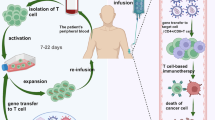Abstract
THE basic/leucine zipper (bZip) transcription factor, CREB, binds to the CRE element (TGANNTCA)1–5. The transcriptional activity of CREB requires phosphorylation of the protein on a serine residue at position 119 (ref. 6). CREs are present in a number of T-cell genes7,8 but the precise role of CREB in T-cell differentiation and function was unknown. Here we show that resting thymocytes contain predominantly unphosphorylated (inactive) CREB, which is rapidly activated by phosphorylation on Ser 119 following thymocyte activation. T-cell development is normal in transgenic mice that express a dominant-negative form of CREB (CREBA119, with alanine at position 119) under the control of the T-cell-specific CD2 promoter/enhancer. In contrast, thymocytes and T cells from these animals display a profound proliferative defect characterized by markedly decreased interleukin-2 production, Gl cell-cycle arrest and subsequent apoptotic death in response to a number of different activation signals. This proliferative defect is associated with the markedly reduced induction of c-junc-fos Fra-2 and FosB following activation of the CREBA119 transgenic thymocytes. We propose that T-cell activation leads to the phosphorylation and activation of CREB, which in turn is required for normal induction of the transcription factor API and subsequent interleukin-2 production and cell-cycle progression.
Similar content being viewed by others
References
Hoeffler, J. P., Meyer, T. E., Yun, Y., Jameson, J. L. & Habener, J. F. Science 242, 1430–1433 (1988).
Gonzalez, G. A. et al. Nature 337, 749–752 (1989).
Habener, J. F. Molec. Endocr. 4, 1087–1094 (1990).
Lee, K. A. W. & Masson, N. Biochim. biophys. Acta. 1174, 221–223 (1993).
Vallejo, M. J. Neuroendocrinology 6, 587–596 (1994).
Gonzalez, G. A. & Montminy, M. R. Cell 59, 675–680 (1989).
Leiden, J. M. A. Rev. Immun. 11, 539–570 (1993).
Calame, K. & Eaton, S. Adv. Immun. 43, 235–275 (1988).
Ginty, D. D. et al. Science 260, 238–241 (1993).
Hidaka, H., Inagaki, M., Kawamoto, S. & Sasaki, Y. Biochemistry 23, 5036–5041 (1984).
Greaves, D. R., Wilson, F. D., Lang, G. & Kioussis, D. Cell 56, 979–986 (1989).
Lake, R. A., Wotton, D. & Owen, M. J. EMBO J. 9, 3129–3136 (1990).
Lee, C. Q., Yun, Y., Hoeffler, J. P. & Habener, J. F. EMBO J. 9, 4444–4465 (1990).
Struthers, R. S., Vale, W. W., Arias, C., Sawchenko, P. E. & Montminy, M. R. Nature 350, 622–624 (1991).
Hummler, E. et al. Proc. natn. Acad. Sci. U.S.A. 91, 5647–5651 (1994).
Smith, K. Curr. Opin. Immun. 4, 271–276 (1992).
Rothenberg, E. V. Adv. Immun. 51, 85–214 (1992).
Kisielow, P. & von Boehmer, H. Adv. Immun. 58, 87–209 (1995).
Jain, J., McCaffrey, P. G., Valge, A. V. & Rao, A. Nature 356, 801–804 (1992).
Boise, L. H. et al. Molec. cell. Biol. 13, 1911–1919 (1993).
Berkowitz, L. A., Riabowol, K. T. & Gilman, M. Z. Molec. cell. Biol. 9, 4272–4281 (1989).
Sheng, M., Dougan, S. T., McFadden, G. & Greenberg, M. E. Molec. cell. Biol. 8, 2787–2796 (1988).
Ofir, R., Dwarki, V. J., Rashid, D. & Verma, I. M. Gene Express. 1, 55–60 (1991).
Wagner, A. J., Kokontis, J. M. & Hay, N. Genes Dev. 8, 2817–2830 (1994).
Shi, Y. et al. Science 257, 212–214 (1992).
Harrington, E. A., Bennett, M. R., Fanidi, A. & Evan, G. I. EMBO J. 13, 3286–3295 (1994).
Wang, C. Y., Petryniak, B., Thompson, C. B., Kaelin, W. G. & Leiden, J. M. Science 260, 1330–1335 (1993).
Karpinski, B. A., Morle, G. D., Huggenvik, J., Uhler, M. D. & Leiden, J. M. Proc. natn. Acad. Sci. U.S.A. 89, 4820–4824 (1992).
Schmid, I., Uittenbogaart, C. H., Keld, B. & Giorgi, J. V. J. immun. Meth. 170, 145–157 (1994).
Author information
Authors and Affiliations
Rights and permissions
About this article
Cite this article
Barton, K., Muthusamy, N., Chanyangam, M. et al. Defective thymocyte proliferation and IL-2 production in transgenic mice expressing a dominant-negative form of CREB. Nature 379, 81–85 (1996). https://doi.org/10.1038/379081a0
Received:
Accepted:
Issue Date:
DOI: https://doi.org/10.1038/379081a0
- Springer Nature Limited
This article is cited by
-
Cell signaling activation and extracellular matrix remodeling underpin glioma tumor microenvironment heterogeneity and organization
Cellular Oncology (2023)
-
What turns CREB on? And off? And why does it matter?
Cellular and Molecular Life Sciences (2020)
-
Wnt/β-catenin signaling contributes to articular cartilage homeostasis through lubricin induction in the superficial zone
Arthritis Research & Therapy (2019)
-
Identification of specific feed-forward apoptosis mechanisms and associated higher survival rates for low grade glioma and lung squamous cell carcinoma
Journal of Cancer Research and Clinical Oncology (2018)
-
A threshold level of NFATc1 activity facilitates thymocyte differentiation and opposes notch-driven leukaemia development
Nature Communications (2016)





